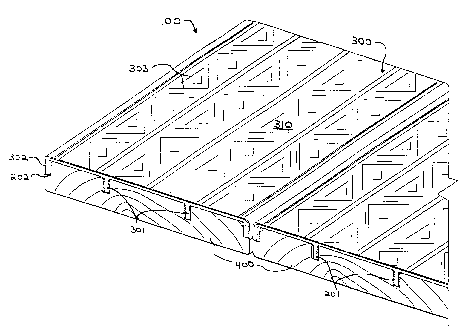Some of the information on this Web page has been provided by external sources. The Government of Canada is not responsible for the accuracy, reliability or currency of the information supplied by external sources. Users wishing to rely upon this information should consult directly with the source of the information. Content provided by external sources is not subject to official languages, privacy and accessibility requirements.
Any discrepancies in the text and image of the Claims and Abstract are due to differing posting times. Text of the Claims and Abstract are posted:
| (12) Patent: | (11) CA 2230537 |
|---|---|
| (54) English Title: | DECKING SYSTEM |
| (54) French Title: | SYSTEME DE CONSTRUCTION DE TABLIER |
| Status: | Expired and beyond the Period of Reversal |
| (51) International Patent Classification (IPC): |
|
|---|---|
| (72) Inventors : |
|
| (73) Owners : |
|
| (71) Applicants : |
|
| (74) Agent: | KIRBY EADES GALE BAKER |
| (74) Associate agent: | |
| (45) Issued: | 2002-05-21 |
| (22) Filed Date: | 1998-02-26 |
| (41) Open to Public Inspection: | 1999-03-15 |
| Examination requested: | 1998-02-26 |
| Availability of licence: | N/A |
| Dedicated to the Public: | N/A |
| (25) Language of filing: | English |
| Patent Cooperation Treaty (PCT): | No |
|---|
| (30) Application Priority Data: | ||||||
|---|---|---|---|---|---|---|
|
A decking system utilizing non-skid plastic covers applied to specially
sawn wooden deck members is disclosed. The wooden deck members include a
plurality of channels or "kerfs" which are sawn or notched into one side of each
deck member. The covers have leg members which are specifically designed to
match or mate with the kerfs of the deck members. The kerfs of the deck
members and the leg members of the plastic covers have dimensions which allow
for the expansion and contraction of the deck members, as well as the
cross-sectional expansion and contraction of the covers, during periods of extreme
atmospheric conditions.
La présente invention a pour objet un système de construction de tablier utilisant des éléments de revêtement en plastique antidérapant posés sur des éléments d'ossature en bois sur lesquels des traits de scie ont été préalablement pratiqués. Chaque élément de l'ossature en bois du tablier comporte, sur une de ses faces, une série de traits de scie préalablement effectués. Les éléments de revêtement en plastique comportent des pattes qui sont spécialement conçues pour correspondre à l'emplacement des traits de scie effectués sur les éléments de l'ossature. Les dimensions des traits de scie, des pattes et des éléments de revêtement en plastique laissent place aux mouvements de dilatation et de contraction des éléments de l'ossature, de même qu'à la dilatation et à la contraction transversales des éléments de revêtement survenant durant les périodes de conditions atmosphériques extrêmes.
Note: Claims are shown in the official language in which they were submitted.
Note: Descriptions are shown in the official language in which they were submitted.

2024-08-01:As part of the Next Generation Patents (NGP) transition, the Canadian Patents Database (CPD) now contains a more detailed Event History, which replicates the Event Log of our new back-office solution.
Please note that "Inactive:" events refers to events no longer in use in our new back-office solution.
For a clearer understanding of the status of the application/patent presented on this page, the site Disclaimer , as well as the definitions for Patent , Event History , Maintenance Fee and Payment History should be consulted.
| Description | Date |
|---|---|
| Inactive: IPC from MCD | 2006-03-12 |
| Time Limit for Reversal Expired | 2004-02-26 |
| Letter Sent | 2003-02-26 |
| Grant by Issuance | 2002-05-21 |
| Inactive: Cover page published | 2002-05-20 |
| Inactive: Final fee received | 2002-03-11 |
| Pre-grant | 2002-03-11 |
| Inactive: Entity size changed | 2002-02-20 |
| Notice of Allowance is Issued | 2001-09-12 |
| Letter Sent | 2001-09-12 |
| Notice of Allowance is Issued | 2001-09-12 |
| Inactive: Approved for allowance (AFA) | 2001-09-04 |
| Amendment Received - Voluntary Amendment | 2001-08-02 |
| Inactive: S.30(2) Rules - Examiner requisition | 2001-02-02 |
| Application Published (Open to Public Inspection) | 1999-03-15 |
| Inactive: IPC assigned | 1998-06-08 |
| Classification Modified | 1998-06-08 |
| Inactive: IPC assigned | 1998-06-08 |
| Inactive: First IPC assigned | 1998-06-08 |
| Inactive: Filing certificate - RFE (English) | 1998-05-14 |
| Filing Requirements Determined Compliant | 1998-05-14 |
| Application Received - Regular National | 1998-05-13 |
| Request for Examination Requirements Determined Compliant | 1998-02-26 |
| All Requirements for Examination Determined Compliant | 1998-02-26 |
There is no abandonment history.
The last payment was received on 2002-02-05
Note : If the full payment has not been received on or before the date indicated, a further fee may be required which may be one of the following
Please refer to the CIPO Patent Fees web page to see all current fee amounts.
| Fee Type | Anniversary Year | Due Date | Paid Date |
|---|---|---|---|
| Application fee - small | 1998-02-26 | ||
| Request for examination - small | 1998-02-26 | ||
| MF (application, 2nd anniv.) - small | 02 | 2000-02-28 | 1999-11-24 |
| MF (application, 3rd anniv.) - small | 03 | 2001-02-26 | 2001-02-06 |
| MF (application, 4th anniv.) - standard | 04 | 2002-02-26 | 2002-02-05 |
| Final fee - standard | 2002-03-11 |
Note: Records showing the ownership history in alphabetical order.
| Current Owners on Record |
|---|
| JOHN D. HITE |
| Past Owners on Record |
|---|
| None |